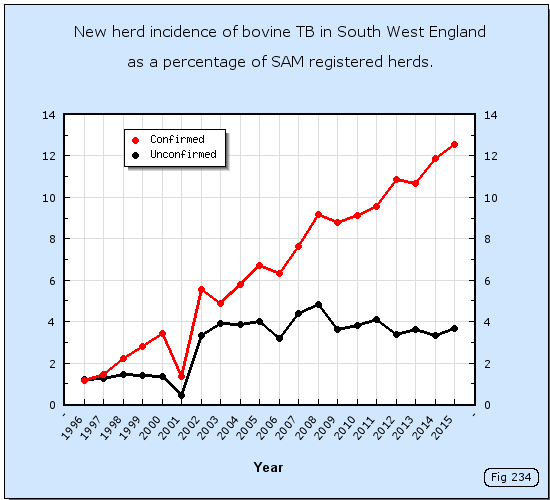Why Liz Truss's vow to tackle bovine TB means so little.
First published 10Jun2016.Elizabeth Truss DEFRA Secretary of State speaking at the Royal Cornwall Show this year said she was absolutely determined to deal with and eradicate bovine TB. However the minister's capacity to act should be gauged by the funds she can allocate and not by the words she speaks.
The following graph of TB incidence in South West England gives an indication of how bad the situation is and the rate at which it is getting worse.

There is obviously large opposition to culling badgers. Also current challenges with vaccinating badgers rule it out for application over areas large enough to have national impact. This is why the current administration is setting its sights on objectives which largely depend on how the problem is addressed in cattle and protecting the low risk areas. However the biggest potential deliverable for reducing TB is in addressing the rapidly increasing TB situation in South West England. So why is the problem not being addressed there?
Government ministers are in a very difficult position. They may wish to address the source of the problem, which is in high risk areas, but they are unable to propose effective actions. This is because MPs, whose job it is to represent their constituent wishes, cannot offer their support to any motion which a minister proposes which involves culling enough badgers to make a difference. WildCRU are doing very good work at Oxford University in their studies of badger population dynamics. They are finding that the badger population is very sensitive to a succession of mild winters which boosts the number of cubs born each Spring. In terms of controlling TB in cattle, the solution does somewhat depend on how TB is being transmitted to cattle and the relative importance of how TB is being transmitted between the species. The RBCT was set up to identify the size of the role played by badgers. Unfortunately it now appears that the team responsible for managing the trial and analysing the results grossly over-estimated the detrimental impact of perturbation. In March 2016, DEFRA reluctantly supplied to me, after involvement of the Information Commissioner's Office, a very comprehensive set of raw data extending from 1986 to 2012 in the RBCT triplets. This dataset was large enough to allow cattle TB to be simply plotted from the raw data. The results clearly show that perturbation did not significantly increase TB incidence in the adjoining lands whilst the TB drop in treatment areas was both substantial and sustained. Prof Christl Donnelly who was the chief statistician in the ISG, helped to design the trial and was second in charge to Prof Bourne, is now saying that the direct transmission from badgers to cattle is a very small proportion and that, although badgers may lead to about 50% of TB in cattle, the bulk of this is due to onward cattle-to-cattle transmission. In view of the team's misleading account of how perturbation substantially reduced the benefit of badger culling in the RBCT, I really do not know what to think.
I suspect that greatest reductions in TB will not be achieved by piling additional resources into extra measures to reduce transmission from cattle but by starting to invest in effective measures to reduce transmission from badgers. It is the lack of ability to address TB in badgers that is resulting in the South West England problem. Measures which address cattle transmission are helping to keep TB at bay in low risk areas such as in the North of England. However these cattle measures are insufficient to keep TB in check in South West England. DEFRA's funding is dependent on how ministers are able to allocate the public purse. Ministers can only direct funds towards effective ways of addressing the problem in badgers if MP's can support them and this support is not there. As a result very little effort is going towards improving prospects for effective control in badgers. This is in spite of this being the key to tackling the problem in areas such as South West England. Since the vast majority of available resource has gone into addressing the problem in cattle, there is an oasis of potential for solving the problem in badgers. Unfortunately there are very little funds being channelled into badly needed development of methods to remove badgers. In addition to this, in the current removal operations, people need to make substantial commitments to sign up landowners and coordinate the culling effort. Are these people being adequately rewarded? Farmers are paying large sums of money. Are processes and accounts being properly audited?
Regarding the pressure on ministers, Alun Davies the ex Welsh minister, who was responsible for shifting badger culling to badger vaccination in Wales, clearly explained his motives by referring to mathematical reality. Also Keith Meldrum the Chief Veterinary Officer (1988-1997) was quoted in a witness-seminar as follows.
One Minister said: 'No, you will do nothing about badgers whatsoever! You will leave them untouched. No trials, no experiments, no nothing.'
This pressure on ministers and its influence on how ministers can channel funds must be shaping how key players in DEFRA and APHA strive to impress in order to secure funding.